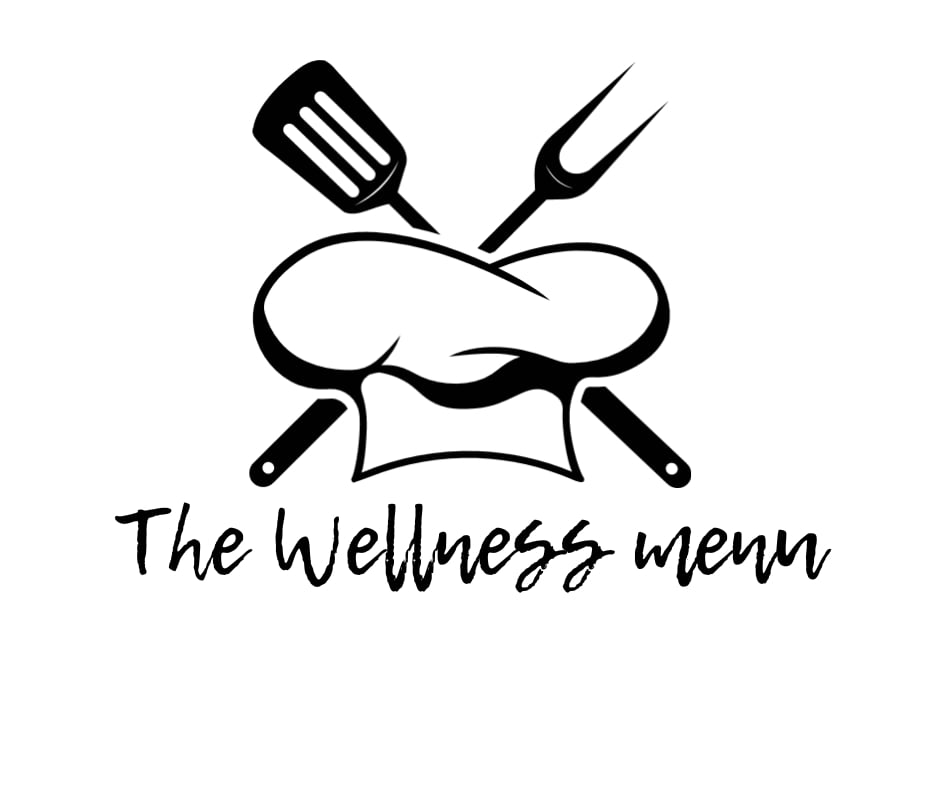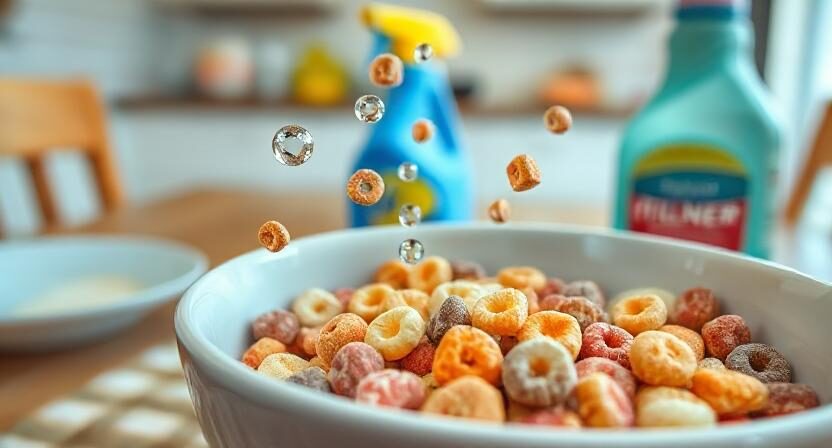
What’s a Paint Cleaner Doing in Your Breakfast Cereal?

In a world where we’re becoming more conscious about the foods we eat, nothing grabs attention quite like the idea that your favorite childhood cereal might share ingredients with paint cleaner. It sounds like a conspiracy theory — but is it?
In a recent video, a creator walks us through a startling comparison: a chemical found in paint thinners, specifically trisodium phosphate (TSP), is also listed as an ingredient in some cereals — including popular brands like Cinnamon Toast Crunch. This revelation is the kind of thing that makes you stop mid-spoonful and ask, “Wait… what am I actually eating?”
Let’s break down the video, analyze the facts, and talk about what it really means for you and your family’s health.
The Shocking Opening: TSP in the Cereal Bowl
The video begins with a bold claim: “Toxic paint cleaner ingredient found in Cinnamon Toast Crunch.” Then we’re taken on a trip to Home Depot, right to the paint cleaner aisle. There, the host shows us a product labeled “TSP Substitute” — phosphate-free. The original TSP, they explain, is no longer carried in stores because of its toxicity when swallowed or inhaled.
So naturally, the big question becomes: if this stuff is considered toxic enough to remove from hardware shelves, why is it still allowed in our food?
The video reveals that TSP — or trisodium phosphate — is used in cereal. And the problem isn’t just the idea of a chemical being present; it’s what TSP breaks down into and how it affects the body.
What Is Trisodium Phosphate (TSP)?
TSP is an inorganic compound, typically used in heavy-duty cleaning products, paint thinners, and degreasers. Its chemical structure allows it to break down tough substances, making it a common go-to in industrial cleaning.
In food, it’s used in small quantities as an emulsifier, texturizer, or pH stabilizer. Food-grade TSP is regulated and added in tiny doses — a far cry from the industrial strength version you’d find in a bucket at Home Depot.
But here’s where the concern comes in: just because something is “allowed” in food doesn’t automatically mean it’s safe long term — or ideal for health. And just because it’s a small dose doesn’t mean it’s harmless, especially when consumed regularly.
The Health Concerns Explained
The video takes a turn toward the science of what happens when TSP is ingested. It breaks down into sodium ions and phosphate — and excess phosphate is where problems start.
Phosphate plays a natural role in the body, particularly in bone health and cellular energy. But too much of it, especially in the form of additives, can overload your system. Studies have linked high phosphate consumption to:
- Neurological and behavioral issues
- Kidney damage
- Cardiovascular problems
- Calcium absorption interference, which can contribute to weaker bones and even osteoporosis
The message? Even though phosphate itself isn’t inherently toxic, consistently consuming it in its processed form may lead to a cascade of health issues — particularly when it’s hidden in everyday foods we trust.
Why Is TSP in Cereal in the First Place?
The obvious follow-up question is: why would a chemical like this be used in cereal at all?
It’s not there by accident. In food production, TSP can serve several technical purposes:
- Acts as a leavening agent
- Helps maintain texture and crunch
- Controls acidity levels
- Prevents discoloration
For food manufacturers, it’s a functional ingredient that helps improve shelf life and the look and feel of the final product. But from a health-first perspective, the functionality comes at a cost.
Regulated Doesn’t Always Mean Healthy
Here’s a reality check: plenty of food additives are FDA-approved and widely used, but that doesn’t make them health-promoting. The FDA evaluates additives based on toxicity at specific doses, not necessarily based on long-term, cumulative effects from regular consumption.
This is especially concerning when the foods in question are marketed to children. Kids are more sensitive to chemicals due to their smaller size and developing bodies — and cereals are a breakfast staple for millions of children every day.
Reading Labels: The Power of Awareness
One of the most powerful moments in the video is the call to action at the end:
“For the love of God, if you see TSP on any food label, especially your kid’s cereal, put it back on the shelf if you wanna live a non-toxic lifestyle.”
That’s a bold statement — and whether or not you agree with the delivery, the point is solid: awareness is everything.
Here’s how you can start protecting yourself and your family today:
- Start Reading Labels Get in the habit of flipping that cereal box around. Look out for not just TSP, but a whole host of preservatives, colorings, and additives you may not recognize. If you can’t pronounce it, look it up. Knowledge is power.
- Choose Whole Food Options Stick to cereals with short ingredient lists and whole grains. Oats, puffed rice, and shredded wheat often have cleaner profiles. Or better yet, swap cereal for homemade oatmeal, smoothie bowls, or eggs with veggies.
- Focus on Organic Brands While not perfect, organic cereals tend to avoid synthetic additives and preservatives. Brands like Nature’s Path or One Degree Organics are generally more transparent and ingredient-conscious.
- Balance Is Key It’s not about fear-mongering or throwing away every box in your pantry. It’s about making smarter choices more often. If your child has cereal once in a while, it’s not the end of the world. But if it’s daily, it may be worth reconsidering.
Understanding the Bigger Picture
The conversation about TSP in cereal isn’t just about one chemical — it represents a much larger issue in modern food manufacturing: the prioritization of product performance over human health.
Crispier flakes. Longer shelf life. Brighter colors.
All of these come with a trade-off, and consumers are rarely told what that is. Instead, it’s hidden in the fine print of a nutrition label — and often disguised behind scientific jargon.
The goal isn’t to scare you away from breakfast. It’s to encourage a more informed relationship with the food you eat.
How This Ties into a Non-Toxic Lifestyle
A non-toxic lifestyle doesn’t mean living in a bubble. It means reducing your exposure to harmful or questionable substances wherever you reasonably can. That includes:
- Food
- Cleaning products
- Personal care items
- Home goods
- Water sources
Every change you make adds up. Swapping one processed cereal for a cleaner version might seem small, but it’s a step toward more conscious living.
And that’s what makes this video so powerful — it challenges us to question the norm.
Other Common Food Additives to Watch Out For
While TSP is getting attention in this case, there are many other food additives that deserve scrutiny:
- BHT & BHA (preservatives)
- Artificial dyes (Red 40, Yellow 5)
- High-fructose corn syrup
- MSG (monosodium glutamate)
- Potassium bromate
- Carrageenan
Start learning about these ingredients. Not everything “approved” is optimal for your health.
Advocating for Change
The more we talk about these issues, the more pressure we put on food manufacturers to do better. Clean-label brands are already disrupting the market, and consumer demand is driving change. You have a voice — and it’s as powerful as your purchasing habits.
Want to go further?
- Write to brands asking for cleaner formulas
- Support companies that prioritize health
- Share educational content with friends and family
- Join advocacy groups focused on food safety and transparency
Wrapping It Up: Don’t Panic — But Do Pay Attention
Let’s be real — most people aren’t chemists. We trust that the products on store shelves are safe. And to a degree, they are — at least in the short term. But long-term wellness requires a more proactive approach.
The video about TSP in cereal might feel extreme to some, but it raises questions we should all be asking. Not to spark fear, but to spark curiosity.
Start reading. Start asking. Start choosing differently.
Because what goes into your body — and especially your child’s body — matters.
And maybe, just maybe, breakfast shouldn’t come with a side of industrial-grade phosphate.
Recommended Recipes
What’s a Paint Cleaner Doing in Your Breakfast Cereal?


Kirsten Hamilton
In a world where we’re becoming more conscious about the foods we eat, nothing grabs attention quite like the idea that your favorite childhood cereal might share ingredients with paint cleaner. It sounds like a conspiracy theory — but is it?
In a recent video, a creator walks us through a startling comparison: a chemical found in paint thinners, specifically trisodium phosphate (TSP), is also listed as an ingredient in some cereals — including popular brands like Cinnamon Toast Crunch. This revelation is the kind of thing that makes you stop mid-spoonful and ask, “Wait… what am I actually eating?”
Let’s break down the video, analyze the facts, and talk about what it really means for you and your family’s health.
The Shocking Opening: TSP in the Cereal Bowl
The video begins with a bold claim: “Toxic paint cleaner ingredient found in Cinnamon Toast Crunch.” Then we’re taken on a trip to Home Depot, right to the paint cleaner aisle. There, the host shows us a product labeled “TSP Substitute” — phosphate-free. The original TSP, they explain, is no longer carried in stores because of its toxicity when swallowed or inhaled.
So naturally, the big question becomes: if this stuff is considered toxic enough to remove from hardware shelves, why is it still allowed in our food?
The video reveals that TSP — or trisodium phosphate — is used in cereal. And the problem isn’t just the idea of a chemical being present; it’s what TSP breaks down into and how it affects the body.
What Is Trisodium Phosphate (TSP)?
TSP is an inorganic compound, typically used in heavy-duty cleaning products, paint thinners, and degreasers. Its chemical structure allows it to break down tough substances, making it a common go-to in industrial cleaning.
In food, it’s used in small quantities as an emulsifier, texturizer, or pH stabilizer. Food-grade TSP is regulated and added in tiny doses — a far cry from the industrial strength version you’d find in a bucket at Home Depot.
But here’s where the concern comes in: just because something is “allowed” in food doesn’t automatically mean it’s safe long term — or ideal for health. And just because it’s a small dose doesn’t mean it’s harmless, especially when consumed regularly.
The Health Concerns Explained
The video takes a turn toward the science of what happens when TSP is ingested. It breaks down into sodium ions and phosphate — and excess phosphate is where problems start.
Phosphate plays a natural role in the body, particularly in bone health and cellular energy. But too much of it, especially in the form of additives, can overload your system. Studies have linked high phosphate consumption to:
- Neurological and behavioral issues
- Kidney damage
- Cardiovascular problems
- Calcium absorption interference, which can contribute to weaker bones and even osteoporosis
The message? Even though phosphate itself isn’t inherently toxic, consistently consuming it in its processed form may lead to a cascade of health issues — particularly when it’s hidden in everyday foods we trust.
Why Is TSP in Cereal in the First Place?
The obvious follow-up question is: why would a chemical like this be used in cereal at all?
It’s not there by accident. In food production, TSP can serve several technical purposes:
- Acts as a leavening agent
- Helps maintain texture and crunch
- Controls acidity levels
- Prevents discoloration
For food manufacturers, it’s a functional ingredient that helps improve shelf life and the look and feel of the final product. But from a health-first perspective, the functionality comes at a cost.
Regulated Doesn’t Always Mean Healthy
Here’s a reality check: plenty of food additives are FDA-approved and widely used, but that doesn’t make them health-promoting. The FDA evaluates additives based on toxicity at specific doses, not necessarily based on long-term, cumulative effects from regular consumption.
This is especially concerning when the foods in question are marketed to children. Kids are more sensitive to chemicals due to their smaller size and developing bodies — and cereals are a breakfast staple for millions of children every day.
Reading Labels: The Power of Awareness
One of the most powerful moments in the video is the call to action at the end:
“For the love of God, if you see TSP on any food label, especially your kid’s cereal, put it back on the shelf if you wanna live a non-toxic lifestyle.”
That’s a bold statement — and whether or not you agree with the delivery, the point is solid: awareness is everything.
Here’s how you can start protecting yourself and your family today:
- Start Reading Labels Get in the habit of flipping that cereal box around. Look out for not just TSP, but a whole host of preservatives, colorings, and additives you may not recognize. If you can’t pronounce it, look it up. Knowledge is power.
- Choose Whole Food Options Stick to cereals with short ingredient lists and whole grains. Oats, puffed rice, and shredded wheat often have cleaner profiles. Or better yet, swap cereal for homemade oatmeal, smoothie bowls, or eggs with veggies.
- Focus on Organic Brands While not perfect, organic cereals tend to avoid synthetic additives and preservatives. Brands like Nature’s Path or One Degree Organics are generally more transparent and ingredient-conscious.
- Balance Is Key It’s not about fear-mongering or throwing away every box in your pantry. It’s about making smarter choices more often. If your child has cereal once in a while, it’s not the end of the world. But if it’s daily, it may be worth reconsidering.
Understanding the Bigger Picture
The conversation about TSP in cereal isn’t just about one chemical — it represents a much larger issue in modern food manufacturing: the prioritization of product performance over human health.
Crispier flakes. Longer shelf life. Brighter colors.
All of these come with a trade-off, and consumers are rarely told what that is. Instead, it’s hidden in the fine print of a nutrition label — and often disguised behind scientific jargon.
The goal isn’t to scare you away from breakfast. It’s to encourage a more informed relationship with the food you eat.
How This Ties into a Non-Toxic Lifestyle
A non-toxic lifestyle doesn’t mean living in a bubble. It means reducing your exposure to harmful or questionable substances wherever you reasonably can. That includes:
- Food
- Cleaning products
- Personal care items
- Home goods
- Water sources
Every change you make adds up. Swapping one processed cereal for a cleaner version might seem small, but it’s a step toward more conscious living.
And that’s what makes this video so powerful — it challenges us to question the norm.
Other Common Food Additives to Watch Out For
While TSP is getting attention in this case, there are many other food additives that deserve scrutiny:
- BHT & BHA (preservatives)
- Artificial dyes (Red 40, Yellow 5)
- High-fructose corn syrup
- MSG (monosodium glutamate)
- Potassium bromate
- Carrageenan
Start learning about these ingredients. Not everything “approved” is optimal for your health.
Advocating for Change
The more we talk about these issues, the more pressure we put on food manufacturers to do better. Clean-label brands are already disrupting the market, and consumer demand is driving change. You have a voice — and it’s as powerful as your purchasing habits.
Want to go further?
- Write to brands asking for cleaner formulas
- Support companies that prioritize health
- Share educational content with friends and family
- Join advocacy groups focused on food safety and transparency
Wrapping It Up: Don’t Panic — But Do Pay Attention
Let’s be real — most people aren’t chemists. We trust that the products on store shelves are safe. And to a degree, they are — at least in the short term. But long-term wellness requires a more proactive approach.
The video about TSP in cereal might feel extreme to some, but it raises questions we should all be asking. Not to spark fear, but to spark curiosity.
Start reading. Start asking. Start choosing differently.
Because what goes into your body — and especially your child’s body — matters.
And maybe, just maybe, breakfast shouldn’t come with a side of industrial-grade phosphate.

The Wellness Menu values your privacy and keeps your personal information secure. We use your data only to provide and improve our services and never share it with third parties unless required by law. By using our website, you agree to this policy.







GIPHY App Key not set. Please check settings